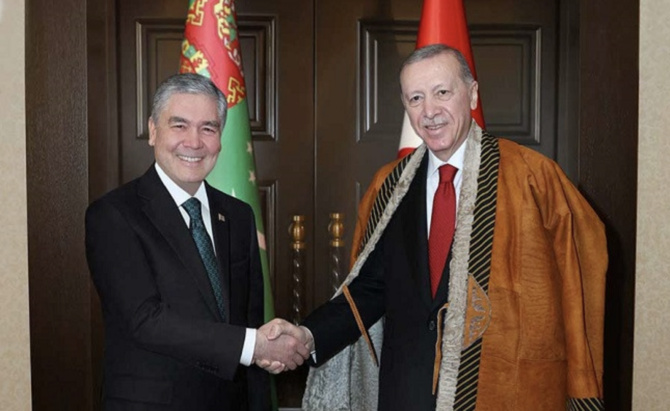Yasar Yaki
Two preliminary documents on natural gas cooperation were signed by Turkiye and Turkmenistan during the Antalya Diplomacy Forum last week. One was a memorandum of understanding and the other a letter of intent. These documents are considered to be the preparatory stages for a full-fledged, binding agreement.
Figures are not always consistent about the size of the natural gas reserves per country, especially because of the discovery of shale gas reserves. However, the order of the countries with the biggest reserves is roughly as follows: Russia (47,800 cubic km), Iran (34,000 cubic km), Qatar (23,900 cubic km), the US (17,710 cubic km) and Turkmenistan (10,000 cubic km).
The main focus of this article is the Trans-Caspian Gas Pipeline. It took too long for the various parties to overcome their disputes on the delineation of the maritime jurisdiction areas and the seabed in the Caspian Sea. Russia and Iran tried to get the lion’s share of control of the sea because it was previously shared only by the Soviet Union and Iran. The dispute was eventually solved when the littoral countries agreed that the laying of gas pipelines along the seabed would only require the approval of those countries whose maritime jurisdiction the pipeline passes through, not all Caspian Sea countries. There are two main pipelines already operational in the region that will ultimately allow the transport of gas from the Shah Deniz sources of Azerbaijan in the Caspian Sea to the southernmost point of Italy. One is the Trans-Anatolian pipeline, which crosses Turkiye from east to west, and the other is the Trans Adriatic Pipeline, which transports gas through northern Greece, Albania and the Adriatic Sea to Italy.
During the Soviet era, the bulk of Turkmen gas was sent to Russia and a smaller quantity to Iran. After the dismemberment of the Soviet Union, Turkmenistan started to export gas to China and India. It is now aiming to diversify its markets. Until the outbreak of the Ukrainian war, one of the alternatives was to send Turkmen gas to Europe through Russia and Ukraine. Now that the Russian route is blocked because of the war, the most suitable route is to go through either Georgia or Armenia.
At one stage, there were misgivings about the relevance of a trans-Caspian pipeline. However, Turkmenistan now seems to be interested in going through Turkiye. Another reason for ambivalence toward the project was the determination of the international status of the Caspian Sea.
This problem now seems to have been eased thanks to the reaching of an agreement. There were three possible routes for the Belt and Road Initiative that China introduced. One was the land and sea route that would go through the Middle East. The second was the route that went through China and Russia, ending up in the Nordic countries. The third was called the “Middle Corridor,” which would go through the South Caucasus and, more precisely, through Azerbaijan and Armenia. This route has now become the most economical because of the problems on the other routes. The Russian route has several problems because of the Ukrainian war. As a result, another route – the Caspian Sea route – came to the forefront. This is also called the Middle Corridor and will go either through Armenia or Georgia. This route has its problems but, as it stands, it looks the most suitable route under the present circumstances.
There is more than one alternative for the Middle Corridor. If the Azerbaijani-Armenian problem ends up with a compromise, the Meghri Corridor, which goes through the south of Armenia, could solve several problems at the same time. When Russian President Vladimir Putin brokered a ceasefire in 2020, he insisted on opening the north-south and east-west corridors through the Armenian territories in order to bring enormous economic activity to the region. If Armenia drags its feet, the oil and gas pipelines will likely avoid the country and instead follow the line that goes from the Caspian Sea to Georgia and from there to Turkiye. The losing side will be Armenia. A similar controversy emerged in the early 1990s, when the shortest route for the Baku-Tbilisi-Ceyhan pipeline project was being debated. Because of Turkiye and Azerbaijan’s mistrust toward Armenia, a longer route that circumvented its territories was decided on. Once the Armenian problem is solved, the remainder of the route to the European oil and gas networks is ready, thanks to the pipelines across Anatolia and the Adriatic.
There is another important project on this route. This is Turkiye and Russia’s idea to make Istanbul, or Thrace, an important hub for oil and gas transit. Russia has raised this issue several times. Whether it will eventually materialize is still to be decided.
Turkmenistan’s oil and gas supplies were mismanaged for decades by the Soviet Union and later by the Russian Federation. It is now on the threshold of a sprint forward, if Turkmenistan does not fall into political instability. Saparmurat Niyazov, the first post-independence president of Turkmenistan, wasted the country’s resources by mismanaging the economy. With reasonable governance, it could overcome many of its problems. Another important subject that was raised during the Antalya Diplomacy Forum was Turkmenistan’s potential membership of the Union of Turkic States. This organization is composed of Turkiye, Azerbaijan, Uzbekistan, Kyrgyzstan and Kazakhstan.
Although Turkmenistan is a Turkic state, it is not a full member but an observer state, as it is permanently neutral like Switzerland. Whether a permanently neutral state like Turkmenistan can become a member of a union in which NATO’s Turkiye is also a member is a debatable subject.







